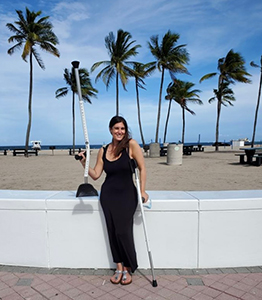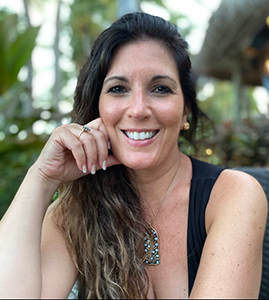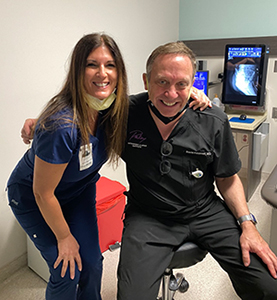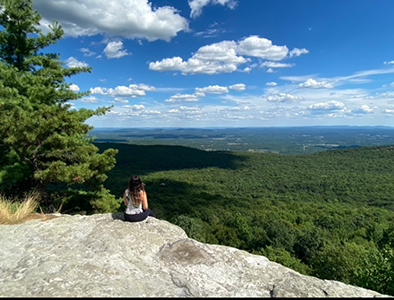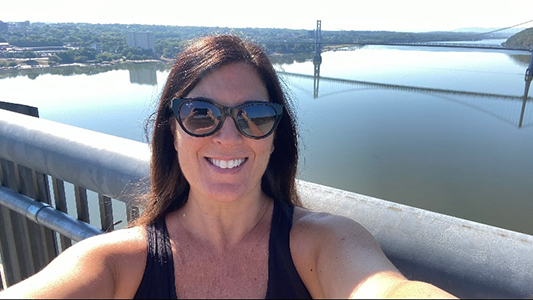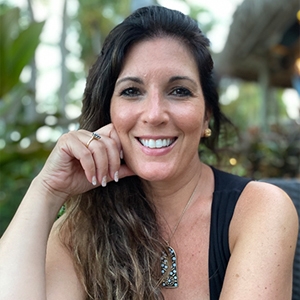Hip Dysplasia (Adult)
Looking back, my hip dysplasia journey began when I was a child. My first signs were evident when I was in preschool and kindergarten and I would complain that my hips hurt to sit ‘crisscross applesauce’ preferring to W-sit or to sit on my knees. My pediatrician told me that my knees were starting to turn inward and if I didn’t correct myself, I would be bow-legged. However, I developed normally and enjoyed my childhood.
Never having been an athlete, no surprise it turns out, I decided when I was 15 to join the track team. I was horrible, to the point of embarrassing. Within two weeks I had so much left hip pain, I began to limp. When my parents noticed me having trouble walking up the stairs, they took me to my first orthopedist. That was the first time I’d heard of hip dysplasia. That was in 1987. He told me I was not going to be a runner. But after a week or so, my pain subsided and I decided not to be a quitter, I went to a track practice. I was feeling better and I didn’t want people to think I was quitting because I wasn’t good at it. Well, that first day back, mid-track, I quickly developed so much pain that I sat down right there and officially gave up.
Over the years, my hips bothered me, but not like they did during my high school track days. Often they felt sore, achy, but didn’t sideline me from enjoying walks for exercise, hikes, and weight training workouts at the gym, among other things.
Until 2015 when after a yoga class of deep hip stretching, I could barely make it up my stairs. Then again that summer when I went home to visit upstate NY and after a moderate hike up Mount Beacon and a simple hike around Lake Minnewaska, that familiar pain began. At that point, I started to give things up… no more leg workouts at the gym turned into no more walking on the treadmill, no more bike, no more elliptical, no more outdoor walks for exercise, no more leisurely strolls down beautiful streets, no more sex, etc.
From 2015 to 2019 I went to different orthopedics who were baffled and had no idea why I was in so much pain. I tried physical therapy, chiropractors, acupuncture, herbs/teas… second, third, fourth opinions coupled with injection upon injection. One surgeon was going to do a bursectomy and the only reason I didn’t go through with it was because the hospital didn’t accept my insurance. I had so much pain, basically 24-hours a day. With all these doctors, I would say “but don’t I have hip dysplasia? Couldn’t this be the reason?” And they would all say, “but you don’t have arthritis.” (YET!) I couldn’t stand too long, sit too long, walk too long, or sleep without chronic pain. My hips hurt, my back hurt, my butt hurt, my thighs even were painful.
In the summer of 2019 I was so debilitated, I felt hopeless and couldn’t imagine how I could possibly go on like this. I used to hide my pain, not wanting anyone to know how really awful I felt, until I could no longer hide it. Never having been a depressed person, I began taking antidepressants. And I began to research hip dysplasia on my own realizing all these doctors are missing something. That was the first time I heard of a PAO and the story was about a patient of Dr. Feldman’s. Reading that story horrified me and I thought, I couldn’t possibly need something like this!! However, during my annual NY visit, I scheduled a consult with a hospital in NYC and my fears were confirmed that a PAO is exactly what I needed. The oldest patient that particular hospital performed a PAO on was a 45 year old. I was already 46 so this scared me even more.
Upon my return to South Florida, I was fortunate to find a hip dysplasia/PAO support group on Facebook. Thankfully, that is where I found Dr. Feldman, the surgeon from that story I read about a few months earlier. Coincidence? I don’t think so. More like divine intervention! I had my consultation with Dr. Feldman in October 2019. I knew after meeting him that he was my guy. I felt confident that I could trust the process and was in skilled hands. Turns out I did start developing arthritis in that left hip but thankfully, Dr. Feldman took a chance on me and I finally had my left PAO in June 2020.
Not going to lie, it wasn’t easy those first couple weeks… but one does not know the heights of their own strength and determination until you no longer have a choice. Not only was I considered old for this surgery, I had been so debilitated with pain going into the surgery that I had no idea how my recovery would go. But my bones were strong and so was I. I came home from the hospital day 5 post-op. And I crutched up NINETEEN stairs to get into my home. And every day and night, I crutched up the stairs to and from my bedroom, And as the weeks flew by, I healed and got stronger and stronger.
I was blessed with an amazing surgeon and his team at The Paley Institute and an amazing support system during my recovery. I am a medical Speech Pathologist in an acute care hospital so I wasn’t allowed to return to work until I was off my crutches completely. I returned to work in October 2020, 3 1/2 months after my surgery. It’s been two years and 3 months since my left PAO and I am doing amazing. This summer, I celebrated my 50th birthday and how blessed I am for how well I am doing. I went home to NY for the first summer since prior to my PAO. For the first time since 2015, I was able to enjoy the Hudson Valley, going on those hikes I used to love my whole life. At work, I am on my feet much of the day and even take the stairs again. I have been doing private Pilates Reformer and am stronger from the inside out.
I may have to do my right hip soon, but I know there is an amazing surgeon with an amazing team who will be there if/when that day comes. And I know how strong I am and how well I will recover. Here’s to living a full life without restrictions and chronic pain. There is hope, and it may take time, but it does get better.
